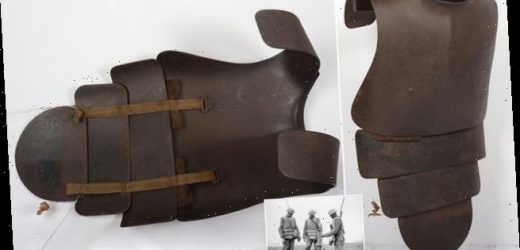Rare body armour worn by German snipers during WWI but often failed to protect against bullet strikes goes up for auction for £2,000
- Armour worn by German snipers in World War One expected to sell for £2,000
- Although meant to protect soldiers from shrapnel and bullets, it often failed this
- The armour is set to be sold by C&T Auctions in Ashford, Kent, on Wednesday
A rare piece of body armour worn by German snipers during the First World War is going up for auction – and is expected to fetch as much as £2,000.
The steel armour, which looks reminiscent of Roman gladiatorial armour, was utilised by snipers and machine gunners in the German army.
The soldiers who wore the armour were those fighting on the Western Front and were stationed in exposed positions.
The armour itself consists of a breast plate and three lower plates, as well as straps and pads.
A rare piece of body armour worn by German snipers and machine gunners during the First World War is set to sell for £2,000 at an auction in Ashford, Kent, on Wednesday
The steel armour was utilised by snipers and machine gunners in the German army who were fighting on the Western Front and were stationed in exposed positions
The armour itself consists of a breast plate and three lower plates, as well as straps (pictured) and pads
Lower sections of the armour could be removed to allow the wearer to change their position more easily during combat.
Despite having been designed to protect the wearer from shrapnel and bullets, the armour often failed this job.
The scarcely-found armour is now set to be sold by C&T Auctions in Ashford, Kent, on Wednesday and has a pre-sale estimated value of £2,000.
Matthew Tredwen, specialist of C&T Auctions, said: ‘This armour was designed for use by snipers and also machine gunners who were left partially exposed during actions.
Despite having been designed to protect the wearer from shrapnel and bullets, the armour often failed this job. Pictured: Three Irish Guardsmen are seen wearing the German armour on July 31, 1917, while examining a captured German machine-gun
Lower sections of the armour could be removed to allow the wearer to change their position more easily during combat
‘The idea was that they would protect against shrapnel and possibly bullet strikes.
‘Sadly, they did not work too well and you do sometimes find examples which have battle damage.
‘It was styled on earlier medieval armour but with the lower parts moveable to make it easier for the troops to move around in combat.
‘It would have been worn with an armoured plate which is worn on the steel helmet.
‘This is a very nice example because it is all complete.’
Matthew Tredwen, specialist of C&T Auctions, said that the steel armour had been designed, based on medieval armour, but had been styled to allow for greater mobility when wearing it
The armour will be sold by C&T Auctions in Ashford, Kent, on Wednesday and has a pre-sale estimated value of £2,000. Pictured: American soldiers trying on captured German body armour in 1918
Source: Read Full Article









